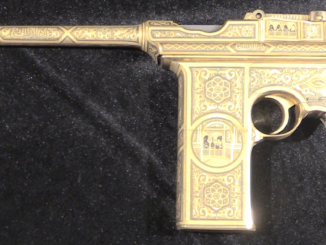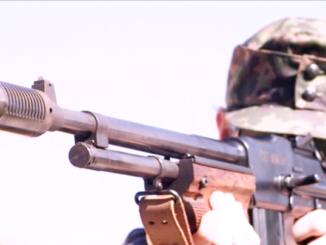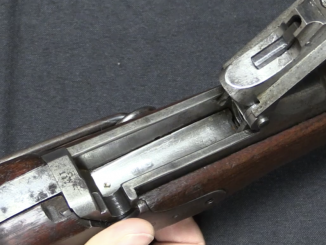Spain was historically a major center of patent infringement in firearms manufacture because its patent law left open a big loophole: patents were only enforceable if the patent holder actually manufactured their guns in Spain. The major European and American firearms manufacturers were not interested in setting up plants in Spain, and so their patents were not enforced there, leaving Spanish shops and factories legally free to copy them.
One of the more successful copies was the “El Tigre“, a clone of the Winchester 1892 lever action rifle made by Garate Anitua y Cia. Ironically, Garate actually registered their own patent on the design since Winchester hadn’t bothered to, and that patent was enforced, since Garate did make the guns in Spain. Their copy was chambered for the .44-40 Winchester cartridge, known in Spain as the .44 Largo. This made it compatible with many of the revolvers in the country of American, Spanish, and Belgian origin, and thus quite popular with a wide variety of groups. Rural citizen militias and the Guardia Civil both used significant numbers of El Tigre carbines. They were also fairly popular in the United States, as the cost was substantially lower than a true Winchester. Many Hollywood films and shows used them as less expensive prop guns, especially for scenes where guns would be handled roughly.
Despite their competitive cost, the El Tigres were actually quite good guns, and served their owners well.




“Spanish shops and factories legally free to copy them”
Click here: http://www.encyklopediezbrani.cz/encyklopedie_zbrani_pistole_spanelsko.html to see overlook of various Spanish automatic pistols. Most of them produced before WW2 are more-or-less copies of other weapons, at least in external appearance. Looking Glass name is mind-boggling for me. It has “LOOKING GLASS” PATENT text. They get español-english dictionary, open random page and say: hey, name this pistol with that words!?
You seem to have your favoured page – Enciclopedia de Armas en Checo. I presume you can read/ comprehend.
When I search for something I usually run 2-3 windows in parallel and enter title as I would call it and it somehow leads (not always) to result.
“Enciclopedia de Armas en Checo”
It is very Zhuk-like (see Жук – Стрелковое оружие), well organized, useful for initial recognition, but with photos (click to see full size image) instead of drawings and covering more modern designs also.
Anyway if you need to id any earlier European fire-arms Стрелковое оружие by Жук is very useful.
“can read”
Tech spec names:
země původu – country of origin
ráže – caliber
délka zbraně mm – overall length mm
délka hlavně mm – barrel length mm
kapacita zás. – capacity
váha gr. – mass grams
rok výroby – year
That’s pretty good, you understand more than I’d have thought. If you have some hang ups let me know. I also have two Zhuk books (in Czech translation). One is on pistols and revolvers, the other is on SMGs and rifles. Drawings in both are shaded side views. Descriptions are quite terse, not much. But for coarse orientation, they are ok.
For VEST POCKET AUTOMATIC PISTOLS see also:
http://www.vestpockets.bauli.at/archiv/archiv.htm
–
More automated automatic pistols database would be useful thing. Just put known data like length, barrel length, mass, caliber or anything you known, then database process using fancy statistic tools and give answer: it is most probably [firm] MODEL [name] AUTOMATIC PISTOL
That is very detailed source – amazing!
I find it amusing that the 6.35mm pocket pistol ended up with the name “Titanic.” To quote one of the most famous Spaniards in cinema history, “You keep using that word. I do not think it means what you think it means.”
Known in Spain as ”Fusil Tigre”. Used by prison guards, special branch of the Guardia Civil (for las enforcement in trains, rural areas) and largely used during the SCW by militias and rear guard troops.
FWIW. A little bit on the correct pronunciation of Spanish verbiage. If a word has no written accent the accentuation is on the first vowel. Thus in Aguila (as in the Mexican 22 ammo) the emphasis is on the first A and it sounds something like AAA-gee-laa, with the long A at the beginning. The U being silent, and so only if it precedes the I. In the case of GUARDIA CIVIL the U is pronounced.(otherwise you are doing the Italian thing) So it should sound something like Gu-aar-dee-aa in English. With emphasis on the first A. The CIA is abbreviation for COMPAÑÍA or company in English, and is legally the equivalent of an LTD following a company name here in the US. So Garate Anitua y CIA would be pronounced accentuating the first A in Garate, and Anitua would be emphasized on the I. Sounding something lie Gaa-ra-te A-neee-tua y com-paa-Ñee-aa to an American ear.
I had no clue what ‘CIA’ is and now you put light on it. So simple, once you know. It is great to have people with different background and level of knowledge here.
The other ending you will often see in place of CIA is S.A. , which stands for Sociedad Anónima, (accentuated on the O) literally meaning Anonymous Society, and is also legalese for LTD, CORP or INC.
I failed to mention previously the U is silent if it precedes an I or an E. So for instance the town of Guernica in Spain would sound like Gar-nee-caa with a hard G, an American sounding first A, and accentuation of the I. Additionally a single R is soft and double RR is hard.
This S.A. for “sociedad anonima’ is also in used in Italian (societa anonima) as I believe. What is intriguing at least to me, is interchangeability of pronunciation between G and H sounds and H and V in Spanish. Its gets tricky to say it right without some local experience.
“….and H and V in Spanish.”
I actually meant -B- and -V-; but who cares, guns have their own language. 🙂
I did some poking around looking around for an El Tigre and they do not seem to be that common, however I was surprized at the abundance of original Winchester 92’s at reasonable prices. Of course the Rossi’s are even more resonable (although I find the calibers, although practical, a bit boring as I am a history buff), but they are sort of the replacement for the El Tigre in the lower cost market I suppose. I remember an Uncle back in the late sixties had a beautiful .32-20 92 octagon barreled rifle with only a few dings which he then proceeded have badly re-blued. It was a nice gun to shoot though. I’ve always wanted one in either .25-20 or 32-20 and never ran across one and now that I am going to be retired maybe I can go back to work and buy some toys. I do have a .30-30 94 Winchester SRC made in 1912 with Villista provenance, but it has a ringed barrel and I don’t want to shoot .30-30 anyways.
Ian, you are a real pain in my arse, every time I see one of your neat videos I want whatever you are exhibiting as I especially like the old, “forgotten” stuff. Hopefully you have been able to help RIA sell some guns.
“Rossi’s are even more resonable (although I find the calibers, although practical, a bit boring as I am a history buff)”
Do you think about converting such weapon to your choice caliber by doing barrel relining?
Not THAT interested in doing that. Why put that much money into “improving” the Rossi when I can get an original for a little over the price of the Rossi plus its conversion also there would be would be no market for resale if I ever decided to sell or trade the Rossi. I have to sell a gun to buy a gun usually. Would love to keep everything but that just doesn’t work out for me… tough being poor and liking so many different guns! 🙂
“Would love to keep everything but that just doesn’t work out for me… tough being poor and liking so many different guns!”
But that is why hobbies are long-lasting – there is not end to it, you can always find new gun/automobile/aeroplane/whatever which you want to have.
“Why”
I think about possibility of rough handling/use, without caring not to damage, because historical value.
A very minor point. I believe the “Winchesters” described in the Eric Blair (AKA George Orwell) book “Homage To Catalonia” about the Spanish Civil War were in fact El Tigres. The description certainly matches.
Sua Sponte
Wasn’t there also some conversion to 45ACP for some of the Tigre rifles? Maybe for the Mexican police?
Guardia Civil is a Spanish rural police corps of military nature, equivalent to French Gendarmerie or Italian Carabinieri. Tough in late XIX century Guardia Civil agents carried usually Remington riles (foot forces) or carbines (cavalry), Spanish copies of model 1873 in .44-40 Winchester were issued to Guardia Civil shock cavalry forces (as some other units of Spanish Army). So the .44-40 Winchester cartridge (known as 44 largo) was produced in Spanish military factories from this period. Later Remingtons and Winchesters were replaced with Mauser rifles and carbines, but rifles used by foot “guardias” were too long for carrying in confined spaces, so in the 1920s some Tigre carbines were purchased and issued mainly to Guardia Civil railway agents.
Ian McCollum is wrong in one point: that one advantage is that it made compatible with many of revolvers. It’s true that .44-40 Winchester or 44 largo was a very popular cartridge in Spain but for rifles never for revolvers. Winchester (1873 and 1892) and Colt Lightning rifles in cal. 44-40 were very popular hunting guns, but production of revolvers in 44-40 was very limited and normally destined for sport to Latin American countries.
Spanish Army until late XIX century had used model 1863 revolvers cal. 11 mm Lefaucheux and copies of S&W no. 3 DA in .44 Russian made by Orbea company, because of that the most popular big bore revolver cartridge in Spain was the .44 S&W Russian or 44 corto (short), military designation: “Cartucho de 11 mm Md. 1884”.
In the case of Guardia Civil, officers used S&W/Orbea revolvers (or, as they purchased their arms, lighter cal. 38 copies); sergeants and O.R. had been traditionally equipped with the same weapons than the Army: rifle with bayonet and sergeants’ or cavalry sabers; but normally not with revolvers. If some of them were issued, these must be Orbea, firing the 11 mm Md. 1884 aka .44 S&W Russian, in any case when the Tigre was issued they had been provided of Star 9 mm automatic pistols.
The so called “Rural citizen militias” may refer to the “Somaten”, that could use Tigres from the twenties on, but never .44-40 revolvers.
Where can I get a cartridge lifter ( platform ) for a .44 wcf ‘. Tigre ‘ this a skeleton model all parts cut away to show workings . Help !!!!! David.
I do not know if it will help you, greetings.
https://postimg.cc/image/bqnreusgl/
My El Tigre was modified (date unknown) to a .44 mag. I purchased it 1965 from the Mathew and Son’s gun shop (out of business, now) in Downey, CA USA. I’ve reconditioned it two times, bluing and cas hardening of some parts. The rear sight was removed and a scope mount installed which covers the mfg. mark and the Tigre stamp is almost invisible due to bluing and polishing. The wood’s are original and never have been touched except for wood oil and wiping down. The action is very tight. Looks good and is fun to shot. The serial number is # 34726 Question: When was it made and where? And or how do I find out? Thanks for any info. JW
More information.
https://www.stockarmas.com/la-carabina-tigre-el-winchester-espanol/
copy-paste in google translator
Regards from Spain.
Love my El Tigre, which was converted by a previous owner to 44 Rem Magnum. Does anyone know where to find replacement parts for these old rifles?
More information.
https://www.stockarmas.com/la-carabina-tigre-el-winchester-espanol/
copy-paste in google translator
Regards from Spain.
I have a el tigre 44-40 rifle that has all markings but has no sadle ring or a place where there was one is this rifle rare or what
I have a “Fine” condition El Tigre that needs some work. Here in Michigan I have not had any luck finding a gunsmith that is knowledgeable/competent to work on it. Sad to say that most “Gunsmiths” simply wish to order replacement parts and install them. When you ask them to actually perform some repairs(Gunsmithing) they are unwilling to do anything!